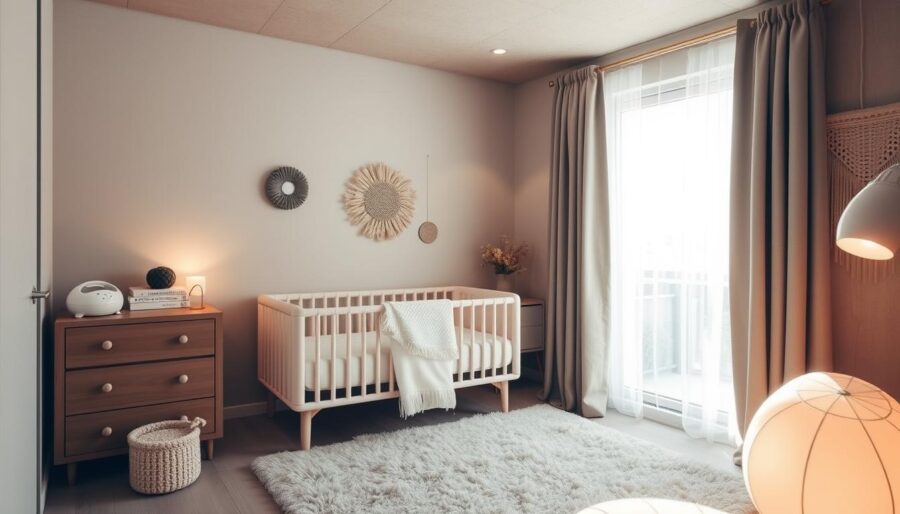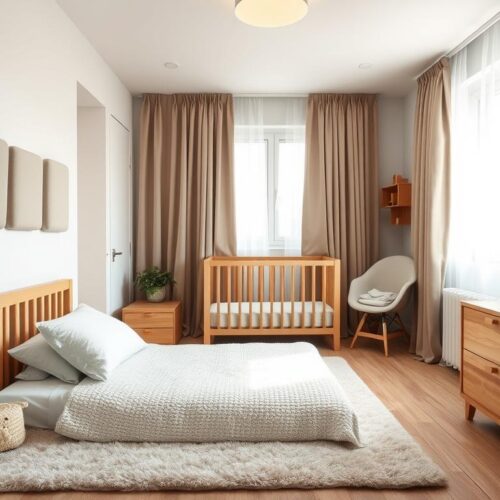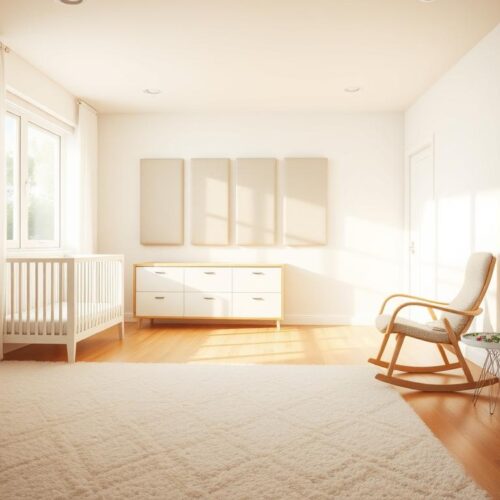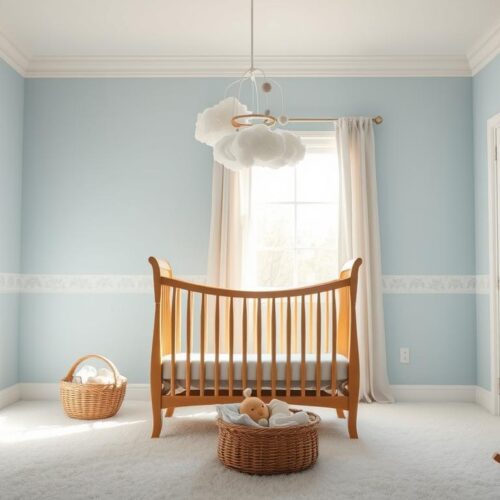Creating a calm room for your baby is very important. Good soundproofing can make a big difference here. It helps your baby sleep better and is good for their health.
This guide will show you how to make the nursery quieter. You’ll learn how sound works and about the best materials to use. Let’s learn how to soundproof your baby’s room together.
The Importance of Soundproofing Baby Room
Soundproofing your baby’s room is vital for their growth. It’s crucial because too much noise harms a child’s health and happiness. Getting rid of these noises means better sleep and mood for you and your baby.
Noises like traffic, loud neighbors, and pets can ruin your baby’s sleep. This can make them stressed and slow their learning. A well-insulated baby room helps avoid these problems, making it peaceful.
Soundproofing is key for your infant’s comfort and supports a calm growth environment. By lowering noise, your baby gets to sleep well and relax. Pick the right soundproofing for your nursery to enjoy a quieter space.
Understanding How Sound Travels
Sound moves like water, flowing through air and different materials. Knowing how sound works is key for making a quiet space for your baby. Sounds can sneak into your baby’s room through small openings.
Common places where sound can get in include:
- Doors
- Windows
- Floors
- Ceilings
- Walls
Knowing where sound might come from lets you soundproof better. By fixing these spots with the right materials, you can lower noise. This makes your baby’s room more peaceful.
Soundproofing Options for Doors
Doors are key in how sound moves, letting noise in or out of a room. To keep your baby’s room quiet, start by soundproofing doors. First, check for gaps around the door frame. Using door seals, like weatherstripping or acoustical sealants, stops sound from leaking.
Thinking of changing the door? Try a solid-core door for less noise than a hollow one. If you can’t replace the door, don’t worry. You can still cut down on noise. Add something heavy to the door, like an acoustic soundboard or thick blankets. These can soak up sound, making the nursery much quieter.
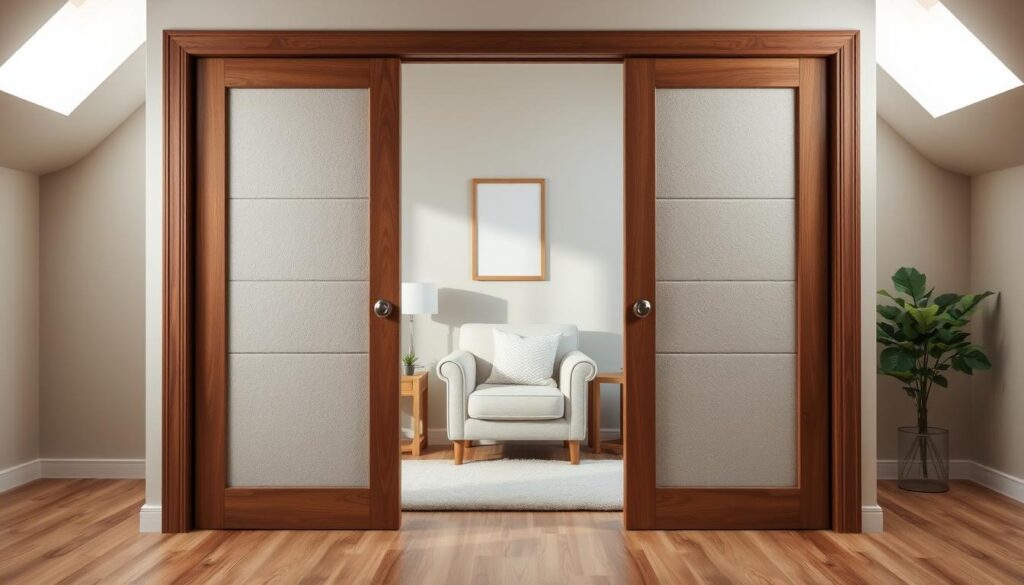
Soundproofing Your Windows Effectively
Windows let a lot of noise into your baby’s room, ruining their sleep. Making your windows soundproof should be a top priority. Installing soundproof curtains can help a lot. They block about 80% of noise from outside. These curtains also make the room look better.
If you don’t want to replace windows, try soundproof inserts. They fit into your current window frames and are not too expensive. Also, make sure your windows are sealed well. You can use acoustical sealants and weatherstripping to close any gaps that let noise in.
Making your nursery’s windows soundproof creates a calm space. Your baby will sleep better in this quiet environment.
Soundproofing Baby Room with Acoustic Panels
Making your baby’s room quiet is key for their good sleep. Acoustic panels cut down on noise and make the nursery calmer. They soak up sound, which lowers echoes and noise. This helps your baby relax and fall asleep easier.
You can pick acoustic panels that look good in the nursery. They’re great at blocking out noise from busy areas or shared walls. Putting fabric-wrapped panels in these spots can really lower the noise.
Acoustic panels do more than make the room quiet. They also look nice. You can choose from many colors and patterns to fit your nursery’s look. This makes sure your baby’s room is both quiet and pretty.
| Feature | Acoustic Panels | Traditional Soundproofing |
|---|---|---|
| Sound Absorption | High | Medium |
| Installation | Easy | Often Complex |
| Design Flexibility | High | Limited |
| Cost | Affordable | Variable |
| Visual Appeal | Attractive | Functional |
Think about using acoustic panels for a peaceful nursery. They’re great at soundproofing and look nice, too. This makes them a top choice for parents who want a calm space for their baby.
Flooring Solutions for Noise Reduction
When setting up a nursery, picking the right flooring is key to lessen noise. The perfect floor can cut down sound, especially in buildings where noises spread easily.
Here are good choices to keep noise down:
- Wall-to-wall carpets: They cover the whole floor and soak up sounds. They’re great for quieting noises.
- Thick area rugs: Putting thick rugs in busy spots helps soak up more sound and makes rooms quieter.
- Soundproof underlayment: For those who like hard floors, soundproof underlayment reduces echo by damping vibrations and stopping sounds.
Choosing soft floors improves sound quality and keeps your child safe by cushioning falls. Pick materials that feel good and cut down on noise.
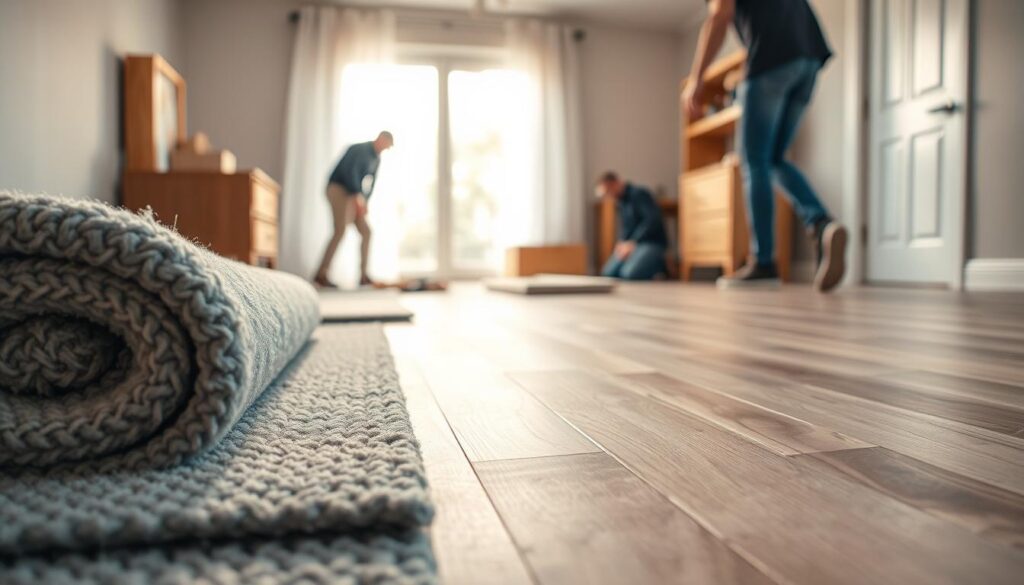
| Flooring Type | Noise Reduction Benefits | Safety Features |
|---|---|---|
| Wall-to-wall carpet | Good at soaking up sound | Soft surface lessens fall impacts |
| Thick area rug | Helps block more sound | Comfortable to walk on |
| Soundproof underlayment | Lowers echo and sound spread | Keeps floor safe and reduces noise |
Adding these floors will make your nursery peaceful and functional. Pick carefully for the right mix of style, safety, and quiet.
Insulating Your Baby’s Room
Making your baby’s room calm is crucial. Insulating it cuts down noises from the rest of your house. Use sound-absorbing materials like mineral wool or acoustic foam on walls and ceilings.
If redoing the room, add another layer of drywall. This makes walls thicker and keeps out more noise. Good insulation means less noise. It also keeps the room cozy and saves energy.
Utilizing White Noise for Calmer Sleeping
White noise machines boost your baby’s sleep by blocking out annoying background sounds. They create a steady sound that helps cancel out abrupt noises. This prevents your baby from waking up suddenly. The soothing effect is similar to sounds heard in the womb, making babies feel secure and calm.
Studies have found that white noise can improve sleep length and quality for babies. This makes these machines a smart addition to any baby’s room. They create a sound environment that helps your baby fall asleep faster and stay asleep longer.
| Feature | Benefits |
|---|---|
| Consistent Sound Output | Drowns out sudden disturbances, promoting uninterrupted sleep. |
| Soothing Ambiance | Creates a comforting environment that resembles the womb. |
| Adjustable Volume | Allows customization to suit your baby’s preferences and needs. |
| Portability | Easily moveable for travel, ensuring sleep quality on the go. |
Other Soundproofing Products for Babies
To make your baby’s nursery quieter, think beyond the basics. Try adding sound-deadening sheets to walls, ceilings, or windows to keep out noise. Acoustic art panels aren’t just nice to look at. They also help silence sounds, making the room calm for your child.
Sound barriers, like heavy curtains or well-placed furniture, boost soundproofing too. For instance, bookshelves packed with books block noise from coming in. Putting dressers against walls absorbs sound, stopping it from moving around the room.
Get inventive with how you arrange the room. The way you position furniture can really change how sound moves. Experimenting with different layouts can surprisingly make the nursery quieter. This helps your baby sleep without disturbances.
Conclusion
Soundproofing your baby’s room is key to a peaceful sleep environment. You can make big improvements with the right steps for your doors, windows, and floors. Using things like acoustic panels and special soundproof materials makes your nursery a calm place for your baby.
Following these soundproofing tips helps your baby sleep better and keeps your home peaceful. Putting effort and resources into this project makes your whole family more comfortable.
Good soundproofing means better sleep and a quieter home. It’s crucial for your child’s growth and your family’s peace. A quiet nursery is very important for everyone’s well-being.

